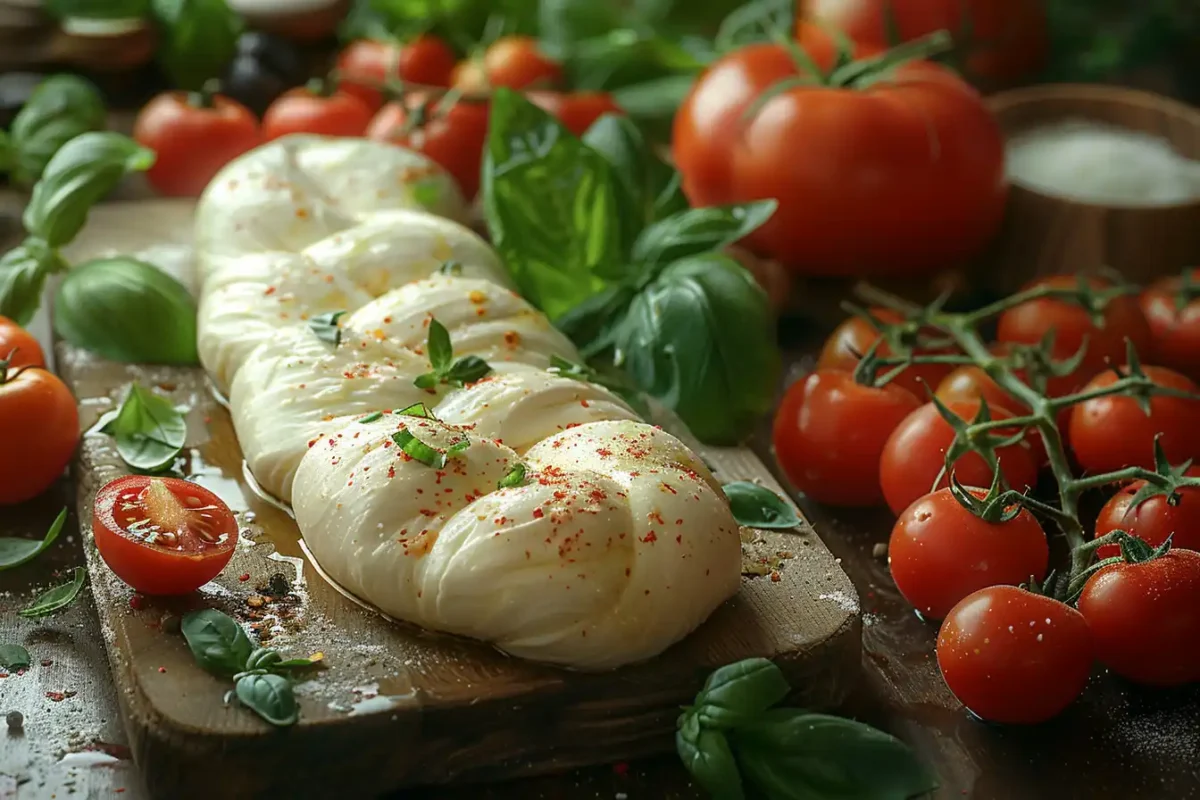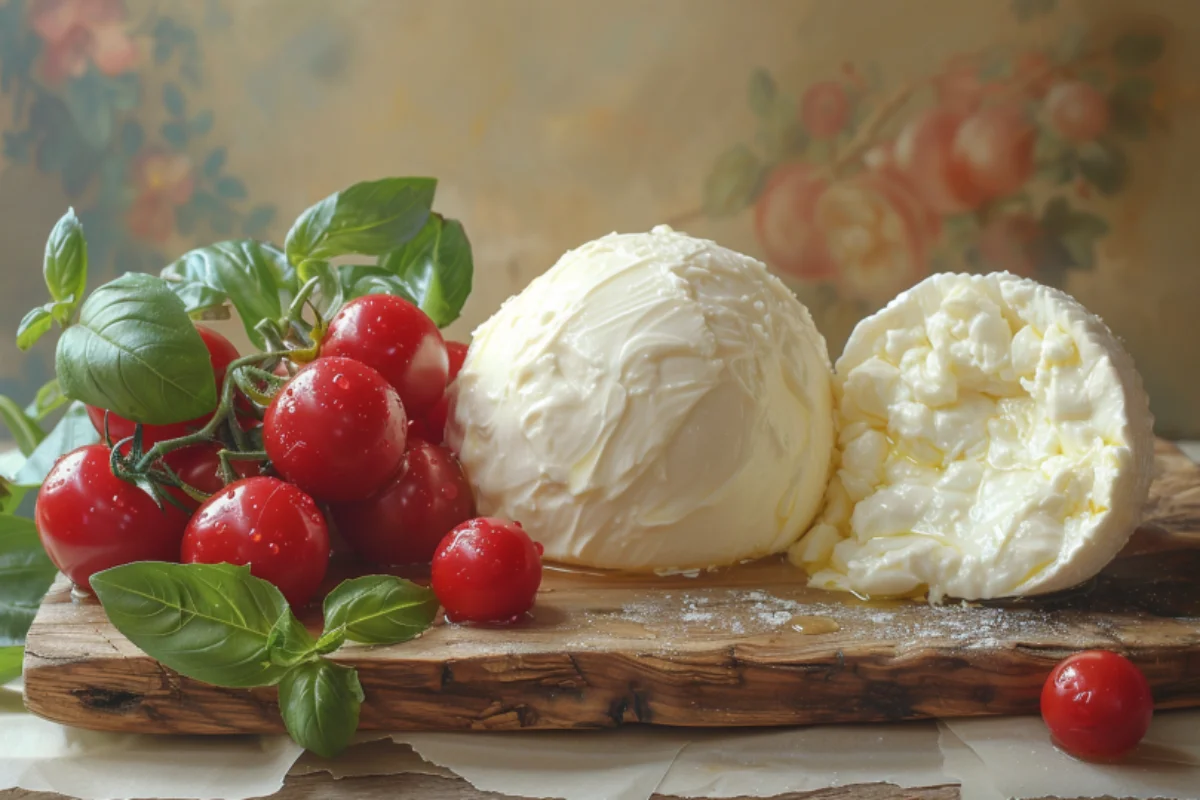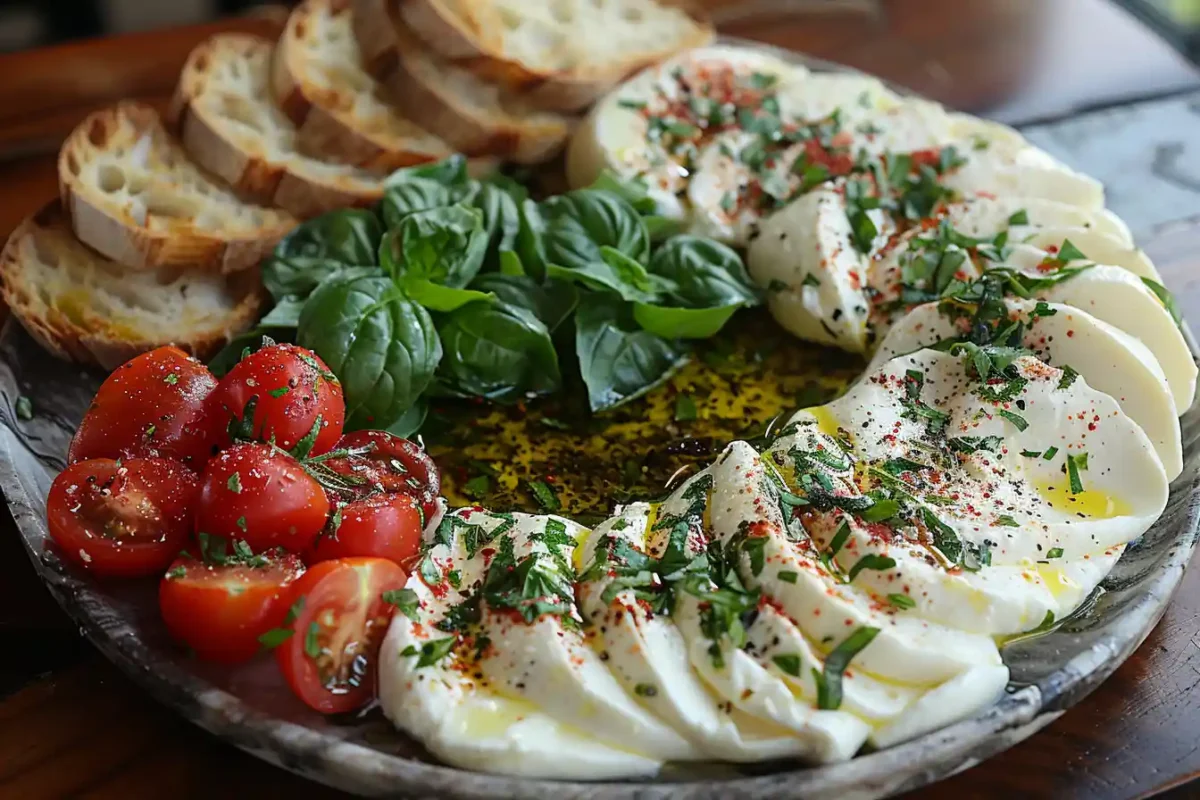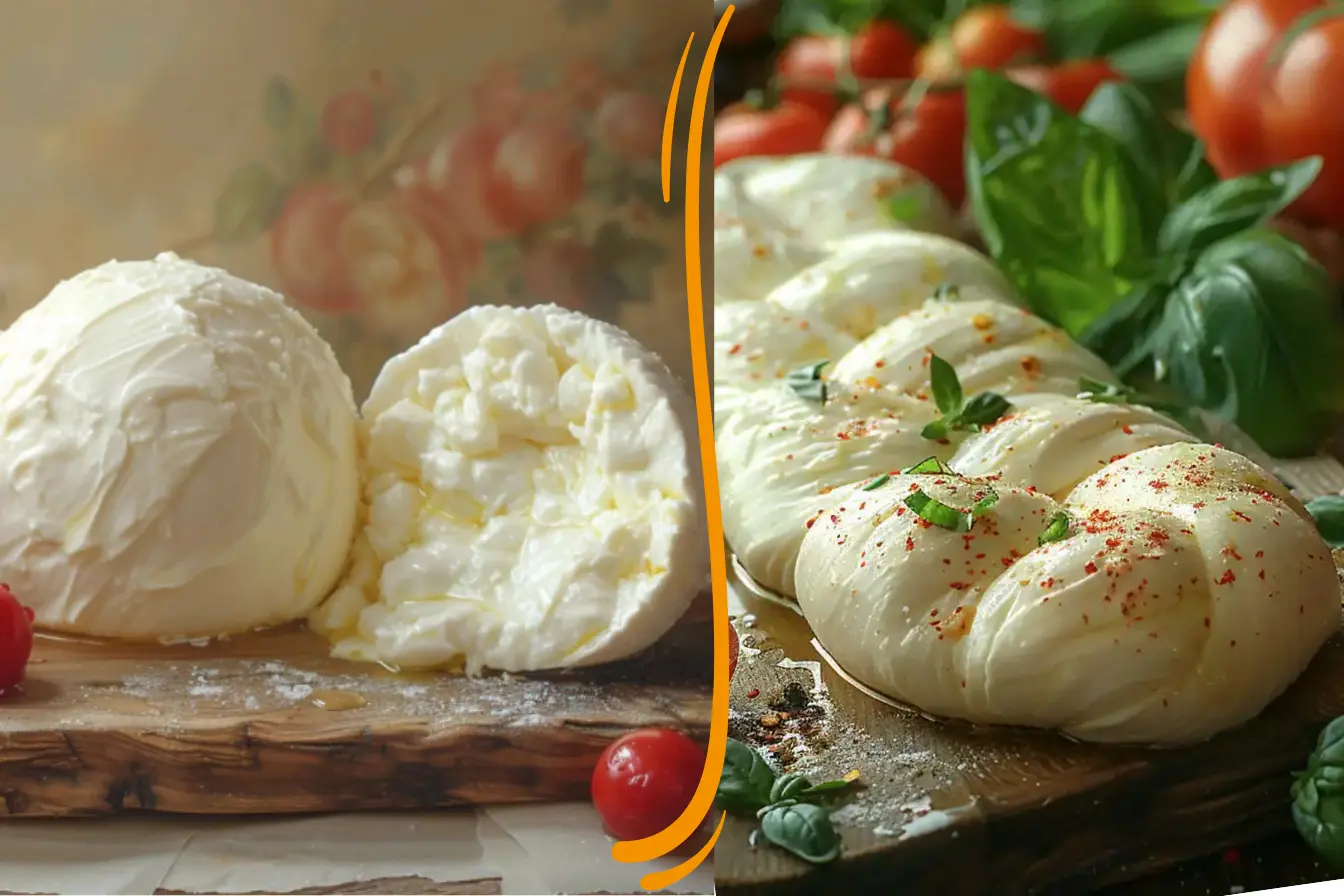If you’ve ever wondered about the difference between mozzarella and burrata, you’re not alone. Both cheeses are creamy, delicious, and a staple in Italian cuisine—but they’re far from identical. One is known for its mild flavor and stretchy texture, while the other offers an indulgent, creamy surprise.
In this guide, you’ll discover the key differences between mozzarella and burrata, including how they’re made, how they taste, and the best ways to use them in your cooking. Whether you’re a home cook looking to level up your recipes or a food enthusiast exploring new flavors, this article will help you choose the perfect cheese for your next dish.
Do you have a favorite way to enjoy mozzarella or burrata? Let us know in the comments, and feel free to share your creations!
Jump to:
Mozzarella vs Burrata: An Overview
What Are Mozzarella and Burrata?
Mozzarella is a fresh Italian cheese, celebrated for its mild flavor and slightly elastic texture. Traditionally made from water buffalo milk in Italy, modern mozzarella often uses cow’s milk, making it more accessible worldwide. It’s a staple in dishes like Caprese salad and Margherita pizza.
Burrata, on the other hand, takes mozzarella to a new level of indulgence. At its core, burrata is a pouch made from mozzarella that’s filled with Stracciatella—a mixture of shredded mozzarella and cream. This gives it a rich, buttery flavor and an irresistible creamy texture.
The Growing Popularity of These Cheeses
The global love for mozzarella and burrata is undeniable. Mozzarella has long been a household name, loved for its versatility and meltability. Burrata, though relatively newer to the international scene, has quickly gained a reputation as the ultimate cheese for gourmet dishes and Instagram-worthy presentations.
Chefs and food enthusiasts alike adore these cheeses for their ability to elevate even the simplest recipes. Whether topping a pizza, crowning a salad, or served simply with olive oil and tomatoes, mozzarella and burrata are at the heart of Italian-inspired cuisine.
How Mozzarella vs Burrata Are Made
How Mozzarella is Made
The process of making mozzarella begins with milk—traditionally from water buffaloes in Italy, but cow’s milk is commonly used worldwide today. The milk is warmed, and rennet is added to curdle it, separating it into curds and whey. The curds are then kneaded and stretched in hot water until they reach the familiar soft, elastic texture of mozzarella. This stretching process, known as pasta filata, is key to mozzarella’s signature consistency.

Mozzarella is typically shaped into balls or logs and can be stored in brine or vacuum-sealed for freshness. This simple, straightforward process makes mozzarella versatile and widely loved for its mild, milky taste.
The Art of Making Burrata
Burrata cheese, while starting with mozzarella, takes the process one step further to create its creamy surprise. First, a thin layer of mozzarella is stretched and shaped into a pouch. The pouch is then filled with stracciatella, a mixture of shredded mozzarella and fresh cream, which gives burrata its rich and velvety texture.
Once filled, the pouch is sealed and cooled. Burrata is often stored in a brine or whey solution to maintain its freshness. Unlike mozzarella, burrata is best enjoyed fresh and within a day or two of production to fully appreciate its luxurious creamy core.
Comparing Mozzarella vs Burrata in Texture and Taste
Mozzarella’s Firmness and Elasticity
Mozzarella is known for its slightly chewy texture and mild, milky flavor. Its elasticity makes it ideal for melting on pizzas or layering in lasagnas. When sliced, mozzarella holds its shape well, making it a popular choice for dishes like Caprese salad.
This firm yet tender texture makes mozzarella a crowd-pleaser that’s versatile for both cooking and snacking. However, its simplicity can sometimes lack the indulgent wow factor that burrata cheese provides.
Burrata’s Creamy and Rich Profile
In contrast, burrata offers a more decadent experience. Its outer mozzarella shell is delicate and soft, giving way to a luscious, creamy interior of stracciatella. This combination of textures makes burrata a standout choice for elevating appetizers and gourmet dishes.
The taste is richer and more buttery compared to mozzarella, thanks to the addition of cream. Its luxurious texture makes burrata perfect for spreading over bread or pairing with ripe tomatoes and olive oil.
Mozzarella vs Burrata: Nutritional Differences
Caloric and Fat Content
When considering what is the difference between mozzarella and burrata, nutrition is an important factor. Mozzarella, being a simpler cheese, is lower in calories and fat compared to burrata. A 1-ounce serving of mozzarella contains roughly 85 calories and 6 grams of fat, making it a popular choice for lighter meals and healthy snacks.
Burrata, on the other hand, owes its higher calorie count to its creamy stracciatella center. The same serving size of burrata can contain around 100 calories and 8 grams of fat. While the extra creaminess adds indulgence, it also increases the cheese’s fat content, making burrata a richer choice for special occasions.
Protein and Nutrient Profiles
Both cheeses are good sources of protein, though mozzarella has a slight edge, offering about 7 grams of protein per ounce compared to burrata’s 5 grams. Mozzarella also provides more calcium, benefiting bone health. However, burrata shines with its luxurious taste and slightly higher vitamin A content, thanks to the cream.
If you’re crafting a dish with nutritional considerations in mind, mozzarella might be the better option. However, when you want to indulge in a decadent treat, burrata’s creamy texture is worth the extra calories.

Mozzarella vs Burrata: Best Culinary Applications
How Mozzarella is Used in Cooking
Mozzarella’s versatility is one of its greatest strengths. It melts beautifully, making it the star ingredient in pizza, lasagna, and baked pasta dishes. Its firm texture allows it to be sliced for Caprese salads, sandwiches, and paninis.
Fresh mozzarella pairs wonderfully with tomatoes, basil, and olive oil for a classic Italian touch. It also works well as a topping for roasted vegetables or as a mild, creamy addition to omelets.
For more mozzarella inspiration, consider recipes that highlight its mild flavor and stretchy texture.
Creative Uses for Burrata
Burrata, with its rich and creamy interior, elevates any dish it touches. Serve it as an appetizer with crusty bread, roasted vegetables, or a drizzle of balsamic glaze. Its soft center makes it ideal for spreading, creating a luxurious base for bruschetta or flatbreads.
In salads, burrata pairs perfectly with sweet fruits like figs or peaches, balancing their sweetness with its buttery flavor. It can also be a show-stopping topping for pizza, added just before serving to preserve its creamy texture. For more fruity inspirations to complement your burrata dishes, explore our collection of Apple Breakfast Recipes: Ultimate Ideas for Healthy, Happy Mornings.
If you’re planning a dinner party or want to impress guests, burrata offers a gourmet flair that’s unmatched. Its versatility extends to desserts, where it can be paired with fresh berries and a touch of honey for a surprising treat. Pair your creamy burrata with our homemade Easy Cottage Cheese Flatbread for a delightful combination of textures and flavors.
The Cultural Roots of Mozzarella vs Burrata
Mozzarella’s Role in Italian Tradition
To fully understand what is the difference between mozzarella and burrata, we must explore their cultural roots. Mozzarella has shaped Italian cuisine for centuries, standing as a cornerstone ingredient. Cheesemakers in the Campania region originally crafted it using buffalo milk, and Italian nobles often enjoyed it as a delicacy. Over time, mozzarella gained popularity, spreading from Italian homes to kitchens worldwide.
Chefs and home cooks alike embrace mozzarella for its simplicity and versatility. From Caprese salads to Margherita pizzas, this cheese represents the freshness and adaptability of Italian culinary tradition.
Burrata’s Artisanal Heritage
In contrast, burrata reflects a more recent, artisanal innovation. Cheesemakers in Puglia created burrata during the early 20th century as a way to use leftover mozzarella scraps. They mixed the scraps with fresh cream to craft the luxurious stracciatella filling, then wrapped it in a soft mozzarella shell.
Although burrata started as a regional specialty, its fame quickly grew. Its creamy texture and rich flavor captivated food lovers, transforming it into a centerpiece for gourmet dishes. Today, chefs worldwide showcase burrata on high-end menus, where it brings elegance to even the simplest meals.

FAQ: Mozzarella vs Burrata
Is Burrata Just a Fancy Mozzarella?
Although burrata begins with mozzarella, it offers a much richer experience. Cheesemakers fill a mozzarella shell with creamy stracciatella, giving burrata its distinctive texture and indulgent flavor.
Why Does Burrata Have Cream Inside?
The creamy filling inside burrata enhances its flavor and creates its signature texture. Cheesemakers combine shredded mozzarella and cream to form stracciatella, which adds a luxurious twist to traditional mozzarella.
Can You Substitute Burrata for Mozzarella?
Substituting burrata for mozzarella depends on the dish. Mozzarella melts easily and works well for pizzas and baked dishes. Burrata, with its creamy core, excels as a topping for salads or appetizers, but it isn’t ideal for melting.
Which Cheese is Healthier?
From a nutritional perspective, mozzarella typically provides a healthier option. It contains fewer calories and less fat than burrata. However, burrata offers a richer, more indulgent choice for special occasions.
Conclusion and Final Thoughts on Mozzarella vs Burrata
Mozzarella and burrata may look similar, but their differences make each one special in its own way. Mozzarella shines with its firm, stretchy texture and mild flavor, making it a go-to for pizzas, salads, and baked dishes. Burrata, on the other hand, offers a rich and creamy indulgence, perfect for gourmet appetizers and fresh pairings with fruits, bread, and olive oil.
“The right cheese can transform a simple dish into something extraordinary—it’s all about knowing when to use which one!”
Final Thoughts
Both cheeses have deep Italian roots and a place in kitchens worldwide. Whether you’re preparing a classic Caprese salad or looking to elevate your next dinner party with burrata’s luxurious texture, choosing the right cheese can take your dish to the next level.
Call to Action
Which cheese do you prefer—mozzarella for its versatility or burrata for its creamy decadence? Share your thoughts in the comments! If you’ve tried a new recipe using either, we’d love to hear about it. 🍽️🚀

